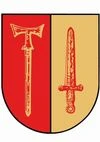Oestereiden
altitude approx. 200 - 290 m above sea level
The district, located in the northern part of the village, is one of the largest districts of Rüthen with more than 800 inhabitants.
In the center of the village is the St. Antonius church, built in 1897/98 in neo-Gothic style.
At the junction of "Ringer Straße" / "Im Rosengarten" one can still find the remains of a Jewish burial ground.
Public and private facilities: Elementary school, gymnasium, 2 sports fields, tennis court, catholic parish home.
In the cemetery of Oestereiden there is a modern cemetery cross. In the indicated beam intersection of the cross there is an opening ("hole to heaven"). The cross was made in 1965 by the sculptor Joh. Dumanski/Munich.
Around 1170 Oestereiden is mentioned for the first time by the Archbishop of Cologne Philipp von Heinsberg as "Eden". However, it remains unclear whether this refers to this village or the neighboring village of Westereiden or perhaps both places together. In 1256 a Latin distinction in the sense of "eastern Eden" appears for the first time as a separate name for the village.
Around 1400 the Lords of Langenstrot moved their noble seat to Eden. They were the owners of the extensive Freigrafschaft of the same name, a court jurisdiction over free land, to whose sphere of action belonged a total of 9 Freistuhls, 4 of which were in the area of the village itself. In 1472 the Freigrafschaft and the Eden property of the Lords of Langenstraße was sold to the Counts of Rietberg, who then got into a protracted dispute over the Freigrafschaft with the noble lords of Büren, who competed with them as feudal lords in the village. This also involved the lucrative rights to the Oestereiden windmill, the tower remains of which still stand today at the northern exit of the village.
In addition, until 1654, the prison and Richtplatz of the Rüthen County Court was located in Oestereiden, which thus also became the scene of numerous witch trials.
The village belonged to the parish of Hoinkhausen until 1898, and a chapel has been documented since 1597. In 1897, the present church dedicated to St. Anthony Em. was built, which has been served by a parish vicar since 1921. Today's local coat of arms refers in its heraldic symbolism to the old free jurisdiction as well as to the chapel's patron saint.
You can find more information at: https://www.oestereiden.de/
